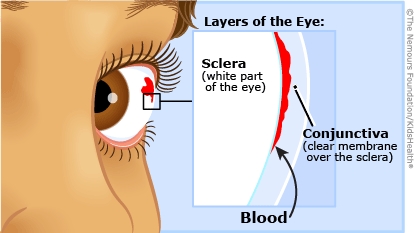- Parents Home
- Para Padres
- A to Z Dictionary
- Allergy Center
- Asthma
- Cancer
- Diabetes
- Diseases & Conditions
- Doctors & Hospitals
- Emotions & Behavior
- First Aid & Safety
- Flu (Influenza)
- Food Allergies
- General Health
- Growth & Development
- Heart Health & Conditions
- Homework Help Center
- Infections
- Newborn Care
- Nutrition & Fitness
- Play & Learn
- Pregnancy Center
- Preventing Premature Birth
- Q&A
- School & Family Life
- Sports Medicine
- Teens Home
- Para Adolescentes
- Asthma
- Be Your Best Self
- Body & Skin Care
- Cancer
- Diabetes
- Diseases & Conditions
- Drugs & Alcohol
- Flu (Influenza)
- Homework Help
- Infections
- Managing Your Weight
- Medical Care 101
- Mental Health
- Nutrition & Fitness
- Q&A
- Safety & First Aid
- School, Jobs, & Friends
- Sexual Health
- Sports Medicine
- Stress & Coping
Subconjunctival Hemorrhage
What Is a Subconjunctival Hemorrhage?
A subconjunctival hemorrhage (sub-con-JUNK-tih-vul HEM-er-ij) is a red spot on the white of the eye. It can look scary, but it’s usually harmless, doesn’t hurt, and won’t affect vision.
Most subconjunctival hemorrhages go away without treatment in a few days or weeks.
What Causes a Subconjunctival Hemorrhage?
The white of the eye (the sclera) is covered by the conjunctiva (kon-junk-TYE-vuh), clear tissue that has many tiny blood vessels. The blood vessels can break and leak blood when the eye is injured or someone has a quick spike in blood pressure. The blood collects between the conjunctiva and the sclera (SKLAIR-uh), leaving a bright red spot on the eye’s surface.
This can happen when someone:
- sneezes
- coughs
- throws up
- strains (for instance, when going to the bathroom)
- has high blood pressure
- takes blood-thinning medicine
- rubs the eye too hard
- wears contact lenses
- has had an eye injury
Subconjunctival hemorrhages can happen in a newborn too. They’re probably caused by pressure changes in the baby’s body during childbirth.
What Are the Signs & Symptoms of a Subconjunctival Hemorrhage?
The telltale bright red spot on the white of the eye is the only sign of a subconjunctival hemorrhage. The spot might:
- get bigger in the first 24–48 hours
- fade from red to yellow
It goes away as the body reabsorbs the leaked blood, and most are gone in 1–3 weeks.
How Is a Subconjunctival Hemorrhage Diagnosed?
Because a subconjunctival hemorrhage doesn’t hurt, many people don’t know they have one until somebody else mentions it or they look in a mirror. Doctors can tell if someone has one by looking at the eye and the spot.
How Is a Subconjunctival Hemorrhage Treated?
A subconjunctival hemorrhage doesn’t cause pain or harm to the eye. They go away on their own and don’t need medical care.
But call your doctor if your child:
- has what looks like a subconjunctival hemorrhage along with eye pain
- gets subconjunctival hemorrhages often


© 1995- The Nemours Foundation. KidsHealth® is a registered trademark of The Nemours Foundation. All rights reserved.
Images sourced by The Nemours Foundation and Getty Images.
Humana Healthy Horizons in Ohio
- Humana Healthy Horizons
- Humana Healthy Horizons Extras
- Member Support
- Care management
- Caregiver resources
- Child well-being
- Disease management
- Documents and forms
- Enrollment
- Grievances and appeals
- Health and wellness
- KidsHealth
- Member Handbook
- New Member Resources
- News and alerts
- OhioRISE Plan
- Pregnancy outcomes
- Tobacco cessation
- Why Humana
- Your primary care provider
- For Providers
- Contact us
- Accessibility
- Humana Healthy Horizons
- Humana Healthy Horizons Extras
- Member Support
- Care management
- Caregiver resources
- Child well-being
- Disease management
- Documents and forms
- Enrollment
- Grievances and appeals
- Health and wellness
- KidsHealth
- Member Handbook
- New Member Resources
- News and alerts
- OhioRISE Plan
- Pregnancy outcomes
- Tobacco cessation
- Why Humana
- Your primary care provider
- For Providers
- Contact us
- Accessibility